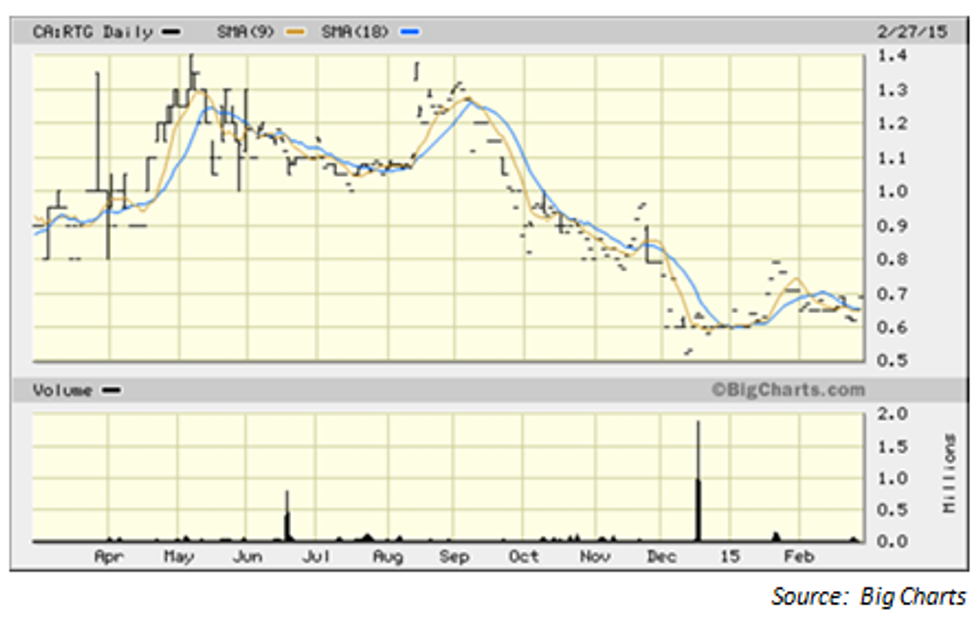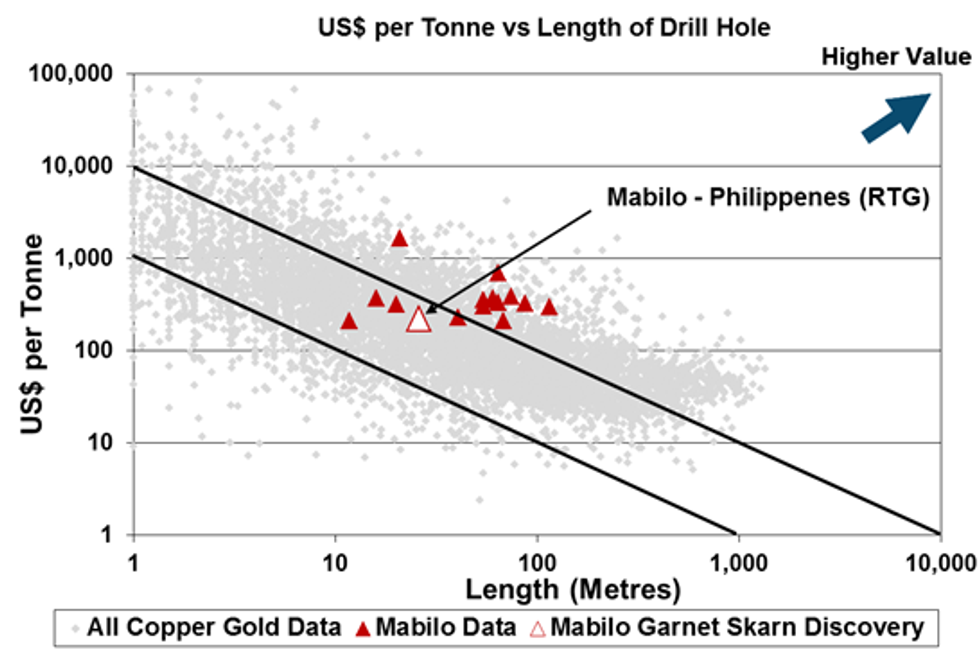Drill Tracker Weekly: RTG Discovers New Garnet Skarn on Mabilo Project in the Philippines
Drill Tracker Weekly highlights drilling results in context with our database of over 10,000 drilling and trenching results. The purpose of this report is to highlight drilling and trenching results that stand out from the pack and compare them to their peer group. This report does not constitute initiation of coverage or a recommendation.
Drill Tracker Weekly highlights drilling results in context with our database of over 10,000 drilling and trenching results. The purpose of this report is to highlight drilling and trenching results that stand out from the pack and compare them to their peer group. This report does not constitute initiation of coverage or a recommendation.
RTG Mining Inc. (TSX:RTG)
Price: $0.69
Market cap: $77 million
Cash estimate: $20.5 million
Project: Mabilo
Country: Philippines
Ownership: 100 percent
Resources: 11.4 million tonnes at 1.80 percent copper, 2.0 g/t gold, 10.6 g/t silver, 44.20 percent iron (total Indicated, Inferred)
Project status: Additional drill results pending in new garnet skarn zone
- RTG Mining Inc. announced the discovery of a new high-grade garnet skarn above the known magnetite skarn mineralization on the recently acquired Mabilo copper-gold-iron project in the in Camarines Norte Province of the Philippines. The project was acquired through the June 2014 merger with Australian based Sierra Mining. The drilling contractor, Galeo, has a right to earn a 42 percent interest in the project (to a depth of 200 meters), by providing US$4.25 million in exploration drilling and management services.
- Hole MDH-095 was designed to target the down-dip extension of the southern edge of the South Body magnetite skarn mineralization at an expected depth of approximately 200 meters.. At a depth of 111 meters, the hole hit a wide zone of garnet skarn mineralization averaging 2.32 percent copper and 1.63 g/t over 25.80 meters (estimated true thickness 23 meters). Further down the hole at 194 meters the hole confirmed the presence of the magnetite mineralization with a 25.60 meter interval of 1.99 percent copper and 1.62 g/t gold. Assays are pending from two additional holes on the same section up-dip and down-dip of MDH-095 which both intersected the garnet skarn unit.
- Mineralization in the main South Body occurs in a 45 degree dipping tabular body of massive magnetite garnet skarn mineralization, with significant copper and gold associated with chalcopyrite, lesser bornite and in the supergene zone, massive chalcocite. In some areas the magnetite has been weathered to form a hematite skarn, with the copper remobilized forming high-grade supergene zones, dominated by chalcocite and massive native copper.
New Garnet Skarn Discovery: 25.80 meters at 2.32 percent copper, 1.63 g/t gold
Deeper Magnetite Skarn intervals: 26.60 meters at 1.99 percent copper, 1.62 g/t gold; 11.70 meters at 1/48 percent copper, 2.79 g/t gold
Disclosure: I, Wayne Hewgill certify that the information in this report is sourced through public documents that are believed to be reliable, but accuracy and completeness as represented in this report cannot be guaranteed. The author has not received payment from any of the companies covered in this report. At the date of this release the author, Wayne Hewgill, owns no shares in the companies in this report.
This report makes not recommendations to buy sell or hold.
Wayne Hewgill is a geologist with extensive knowledge of the global mining industry gained through 30 years of diversified experience in mineral exploration and new business development in Canada, as well as 10 years living in Africa, New Zealand and Australia. He was previously senior research officer at BHP Billiton, an executive with an exploration company working in Argentina and a mining analyst at three Vancouver-based financial groups where he developed the Drill Tracker database in 2006. He holds a B.Sc. in Geology from the University of British Columbia and is registered as a Professional Geoscientist (P.Geo) with APEGBC.







